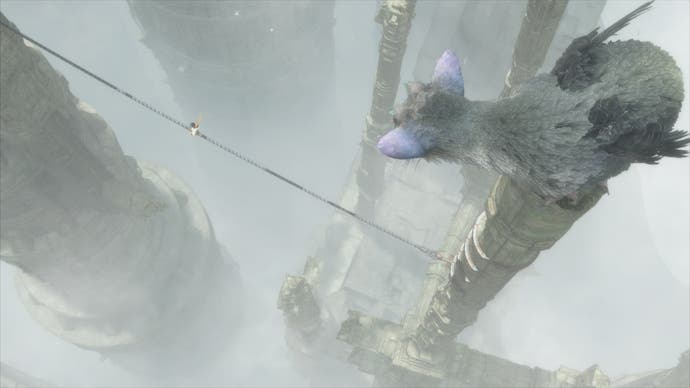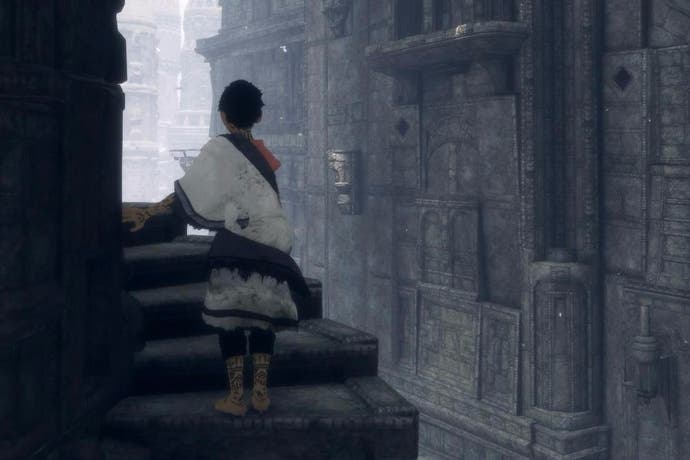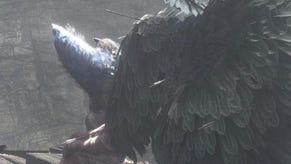Investigating the origins of The Last Guardian's architecture
Shadow of the surrealists.
A wind-scoured castle, crumbling into a sun-bleached sea. A towering shrine, rising above a landscape of decaying ruins and moss-skinned rocks. An isolated tower surrounded by vast chasms, speckled with high-arched walkways and overgrown ledges. Though the games of Fumito Ueda may depict delicate relationships, vast beasts and impregnable mysteries, it has always been their distinctive architectural spaces that gave them a concrete form. Ever since Ico's castle hazily emerged from the bloom and mist on the games title screen in 2001, these monolithic structures have become symbols for the sense of scale, mysticism and artistry that have made Ueda's games instantly recognisable and widely loved.
With The Last Guardian, Ueda and his team at Gen Design and Sony's Japan Studios have once more returned to the ageing stones and high arches of their singular world. Like Ico, the game isolates the player in a vast empty megastructure, tasking them with finding their way through its labyrinthine halls. It's a structure than many games have shared, from the original Metroid through Prince of Persia: The Sands of Time all the way up to this year's Dark Souls 3. However, despite this familiar rhythm of puzzles and vistas, there is something distinct about The Last Guardian's architecture.

It's not something that's easy to put your finger on: there's a strangeness to the heavy blocks, angular buttresses and gridded stonework that isn't instantly recognisable from real life. There's an Aztec feel to the geometric patterning that surrounds The Last Guardian's gates and archways, but it lacks the animal imagery and the stepped forms that make images of ancient cities like Teotihuacan so memorable. There's also something of the ancient architecture of Rajasthan too - in the balconies enclosed by ornate arches and the pillars overflowing with ornamentation - but again, The Last Guardian builds these structures out of simple, ambiguous forms not the strong religious and pictorial details of, say, the Dilwara temples. There are hints of each of these styles, and many more, in Ueda's world, but none seems to fit, each one remaining distantly related. The Last Guardian's real world references remain a mystery then, but there are clues in the Ueda's previous games that begin to explain why that is.
Perhaps the most obvious reference point for the architecture of this loose trilogy of games comes from the first, Ico. I say obvious, because, in Europe and Japan at least, it was printed right on the cover. That cover, painted by Ueda himself, was a direct reference to the Italian surrealist Giorgio De Chirico. Carrying the same arches, the same long shadows and low sun, Ueda's pastiche of De Chirico's style suggests a connection not to real architecture, but instead to that painter's central subject; dreams. Rather than work from life, or real cityscapes, De Chirico based his images on a collage of dreams and memories, aspiring towards what he called a 'childhood vision.' Knowing Ueda's own interest in childhood - especially in The Last Guardian, which is narrated by a man recalling his surreal adventures as a child - it's easy to see why De Chirico was such a strong influence.

And yet, when we look at The Last Guardian we might see bold arches framing yellow light, but we also see an ornate complexity, stone walls covered with dizzying detail. These elaborate surfaces are quite unlike De Chirico's white plaster walls. To find their origin we have to turn to another explicit reference, Gerard Tringac. Mentioned in a handful of the rare interviews Ueda gives, Trignac's fantastical architectural spaces are instantly recognisable in the cavernous interiors of The Last Guardian. Like the carefully crafted vistas in Ueda's game, Trignac's views are almost always framed by archways, the viewer seemingly stood at the bottom of some vast megastructure. Etched with detail, these structures are dotted with an array of windows, doorways and bridges. This means that to look at Trignac's work is to explore it, your eye roving along the scene, connecting entrances and exits with imaginary unseen passages.
It's this trait of Trignac's work that suggests the reason for The Last Guardian's complex architecture. Its details aren't just there to dress the scene, but to provide channels for the player's imagination. When the player gazes up at the game's huge central tower, picking out entrances and exits through the mist, they imagine themselves traversing them in the hours ahead, giving their journey a sense of direction but also providing the sense of a wider, more complex world. Like the 'greebling' of a Star Destroyer's pitted surface, these details also provide a sense of scale, so that in seeing a single doorway player can conceive of the sheer vastness of the surrounding structure. Though Trignac's work, and architecture, is static, it appears somehow porous, allowing the viewer to enter into its world. It's clear that in emulating these structures, The Last Guardian hopes to draw players closer to its world in much the same way.

There is one final architectural influence that Ueda has mentioned, though infrequently, Francesco Piranesi. Like Trignac, Piranesi was trained as an architect - though two centuries before - and like Trignac he also turned not to the construction of real buildings but the creation of fantastical monuments. His etching series Imaginary Prisons is among his most influential, depicting complex interiors of mechanised walkways, staircases and, of course, arches. When Ueda, having never visited a castle, sought to create the interior of one for Ico, it was to Piranesi's work that he turned, rather than photos or drawings of real castles. This is because his intention wasn't to capture exactly what a castle looks like, but what one feels like, what a dream or a fantasy of a castle might be.
This is what connects each of Ueda's influences to one another. De Chirico, Tringac, Piranesi, all of them are artists who rather than diligently copy the architecture from the world around them, sought to invent, dream up and reinvent it for themselves. Not limited by resources, physics and building techniques, they were able to construct true architectural fantasies, buildings that can and never will exist. This too is what marks out the spaces of Ueda's games. Rather than be based on known styles and movements in architecture, the buildings of Ico, Shadow of the Colossus and The Last Guardian are invented on their own terms, following their own logic and style. The Last Guardian, in its references to key artists, but also its distinct architectural personality, is the culmination of this process.
And while Ueda may have sought inspiration from these artists, his end goal was not to copy them, but to follow in their footsteps - creating his own imaginary architecture that might stand alongside these greats. He isn't the first, and there are also shades of Tsutomu Nihei's insanely detailed manga to Ueda's ribbed and lined surfaces, as well as Minoru Nomata's delicate monuments, but despite the similarity of these peers, Ueda's vision for the Last Guardian manages to feel distinct. And in the end, The Last Guardian's architecture, draped in mist, coated in detail, aged with moss, manages to escape pastiche and instead feel like the structures of a half-remembered dream, brought to life.









